QuestionQUESTION: Hello. My question is in regards to our 2 1/2 year old Hermann Tortoise Vicky. She appears to be in good health in terms of appetite, activeness and pinkness of tongue, however over the last few weeks she has been constipated, or at least going less frequently. Over the last day or two we noticed her straining and she appeared to have something hanging but then retracting again. On close inspection it appears to be fleshy and a purple/pink colour, certainly not poo. She managed to squeeze some poo out whilst the other fleshy thing was hanging out and with a little help a large poo was passed and again the fleshy thing retracted. Please could you advise what this might be and if she needs treatment or certain care to assist as we would hate for her to be in any pain. We are aware that her diet may have been a little too high in protein (but she loves peas!). Apart from that she is bathed regularly and has a health check every 6 months (which is where she was sexed). Any help or guidance would be greatly appreciated. Many thanks.
ANSWER: Hi Tom,
If Vicky really is only 2 1/2 years old, she is too young to sex unless she grew much too quickly. Generally in captivity they mature at about four to five years old, although maturity is based more on size than age. If she were in that four to five year age range, I'd suspect that what you're seeing is flashing (that is, Vicky is really a male and showing his penis); however, unless she has grown very quickly something else may be going on. If you could post back with more information on Vicky's size and weight, it would help. A Hermann's of her age should be about 150-200g, but a mature one would be quite a bit bigger (especially if female). My concern is that Vicky may have developed an intermittent prolapse, which could be quite serious (and is often caused by bladder stones). As I said, though, it somewhat hinges on whether Vicky is mature at this point or not.
Hermann's should be fed strictly leafy greens and weeds. No veggies, fruit, or pellets. You should stop feeding anything like peas immediately. I cannot stress this enough. Whether she likes a food or not, if it's not good for her she shouldn't get it, and peas are most definitely not good! The higher protein level may lead her to develop the above-mentioned bladder stones, which are a serious health threat that can require surgery. Dandelion flowers are a good treat that tortoises love. In addition to her soaks, she should have moisture in at least the warm area of her enclosure. Basking lights are very dehydrating, and dehydration can also lead to bladder stones. Make sure she's in a large, open enclosure (not a viv), with UVB as well as the basking bulb.
If you can post back with more information about Vicky, and especially if you can post some clear photos of her, I can give you better advice as to whether this is simply flashing (in which case Vicky is Victor!) or a possible prolapse.
---------- FOLLOW-UP ----------
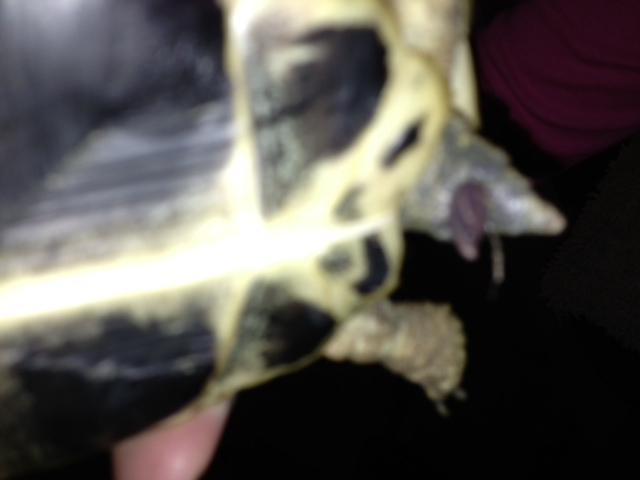 Other
Other
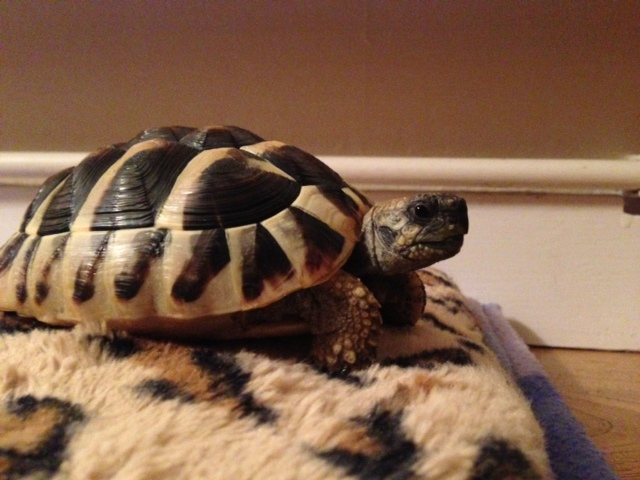 Vicky
Vicky
QUESTION: Hello Janine. Thank you very much for your speedy response. Since our original correspondance she has had another poo unassisted and we have not seen the fleshy item hence I have not managed to take a suitable picture. I have attached a couple of pics and the best I originally had for the 'item' in question but the pic isn't great. We have taken note of the dietry suggestions you have mentioned and have made sure her UV light, heat lamp and water bowl are all available at all times. I will weigh her and provide some measurements also asap. However at her previous health checks it has been suggested that she is of 'good' weight and length - whatever 'good' means.Please let me know any further info you require but I will send more images and details shortly. Many thanks.
ANSWER: HI Tom,
Your picture is a little blurry, but I'm nearly 100% certain that Vicky is a male and flashing. So that's one worry out of the way. However, your other picture shows that Vicky has indeed been growing too fast (hence his maturity at such a young age) and his shell is somewhat malformed because of it--that is, the growth is not as smooth and even as it should be. This is probably due to diet, or perhaps simply eating too much. If you can post back with more information on what you feed and how much, I can help you sort that out.
Bear in mind that most tortoise species don't have a ready food supply available all year round. Generally spring is the time when they eat the most, and there is less and less food available as summer goes on and then hibernation in the winter. So in the wild, hatchlings grow to maturity very slowly--10 years or more. In captivity, our instinct is to treat them like mammals and feed them often, but this isn't necessarily a good thing. With adult tortoises, if you feed daily it should be in fairly small amounts--no more than they can eat in about 15 minutes. My preference is not to feed daily, but to skip at least two days a week. If you have an outdoors planted pen for Vicky in the summer, I would not feed him at all, and instead let him graze. This allows for some natural behavior and more exercise as well. If you watch a tortoise in a large pen, they will nibble at one plant, wander on, nibble at another, wander, etc. So they get exercise while they eat. You might also scatter Vicky's food about her enclosure so that she has to work at it a bit--and it's also a good idea to give her whole pieces of food. Don't chop it up for her; having to rip and tear at food is good for them!
Here's a link to some picture's of Hermann's that show more natural shell growth. If you notice, the growth from the vertebral scutes (backbone) to the marginal scutes (outer) is quite even, whereas Vicky's is uneven so that his marginals look something like a skirt. If he gets on a better diet, any new growth will be smoother, but the abnormal growth can't be fixed, unfortunately. http://chelonia.org/testudo_gallery.htm
---------- FOLLOW-UP ----------
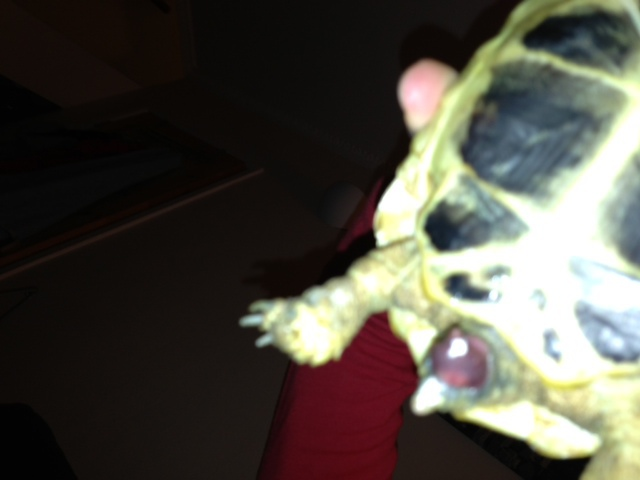 V1
V1 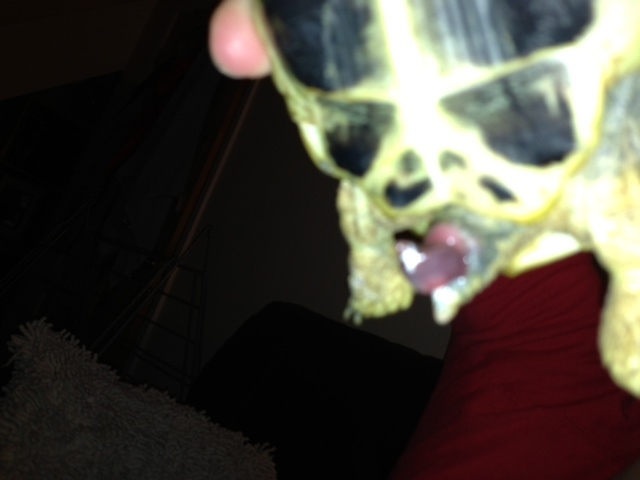 V2
V2
QUESTION: Hello Janine, Thank you for the additional information. I am very dissapointed that we have not done a good job looking after Vicky as we give her so much affection and attention, but clearly to soft when it comes to diet and eating. Up until now she had been eating near enough everyday, not always very much but without restriction. Her diet was varied but included veg and fruit. This is a strict leafy greens diet from now on and in fairness her toilet cycle seems better already.
I have weighed her and she is approx 230g and length is 14cm from top of shell by neck down to tip of shell by tail taking into account the shape of the shell. I have also seen the item in question again and have managed to get a couple of slightly better pictures which I have attached. The white bit on the end was because she/he had just wee'd and sat in it before picking her up to take the picture.
Finally please could you just clarify a couple of general diet questions, can she eat any of the following; baby corn, mange tout, pak choi, rocket cooked or raw carrot, cabbage?
Many thanks for all your help and advice hugely appreciated!
Tom
AnswerHi Tom,
All tortoise keepers have made mistakes, so don't feel too badly. At least you're trying to do the best you can.
When you measure, you want to measure SCL (straight carapace length), which essentially means straight down the shell without the curve. The easiest way to do this is to lay a ruler on the floor perpendicular to a wall. Set the tortoise on the ruler and gently push it up against the wall so the head retracts into the shell. Then read the measurement at the tail end (not including the tail). 230g isn't too bad, although it's on the high side for her age.
As far as the protuberance goes, I still think it's flashing, but have a few more questions for you. When it comes out, does it come out farther than in your pictures, and does it have a sort of spread out end? If so, that's definitely a penis. A prolapse looks more like a bubble, and would look more red. You can google for images of "Hermann's tortoise penis" and "tortoise prolapse" and I think that will help you determine for sure. If you see any pictures of sulcatas, don't be alarmed, haha. Believe it or not, my male Hermann's is 10 years old and I've only seen him flash once. Some do it all the time, and some almost never do.
Of the foods you listed, rocket is OK. Anything like corn or peas is a huge no-no, and you want to avoid the rest. Some do feed carrot very occasionally (not more than once a month), but personally I don't feed anything but greens and weeds, and preferably mostly
weeds. I don't know if you've seen the t lady's site, but she has a great guide to healthy weeds and plants for your tortoise, and she's in the UK.. http://www.tlady.clara.net/TortGuide/diet.htm#plantlist With just one tortoise, it's not too difficult to gather enough weeds during the months when they grow. If you don't know your weeds, her site has pictures that will help. Most tortoise keepers are kind of obsessed with weeds, lol. Some greens you may be able to find in your stores there are turnip and mustard greens, kale, collards, raddichio, watercress, spring mix, and romaine (I think you call it cos). Don't feed too much spring mix or other lettuces because they're not that nutritious and contain a lot of water. Prickly pear cactus is also good if you can get it.
One note on the t lady's recommendations: she does say fruit is OK occasionally, but I disagree with this. Partly because people tend to think "occasionally" is more often than it really is, and also because my aim is always to feed as naturally as possible. The concept of feeding "treats" is a human one; tortoises don't need treats, or at least ones that aren't completely healthy. So if you want to feed treats, give flowers instead of fruit. My guideline is if it's not something very similar to what they would find in the wild, don't feed it.
You are very welcome, and please continue to ask if you have more questions.





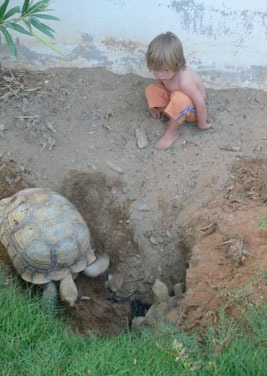 sulcata tortoises
QuestionQUESTION: I have two 11 year old sulcata tortoi
sulcata tortoises
QuestionQUESTION: I have two 11 year old sulcata tortoi
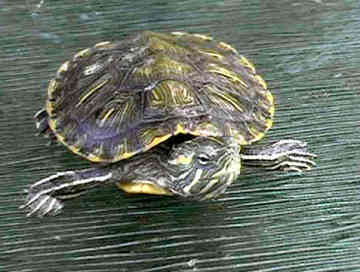 more info
Question
Aimee my turtle
I am not exactly sure how old
more info
Question
Aimee my turtle
I am not exactly sure how old
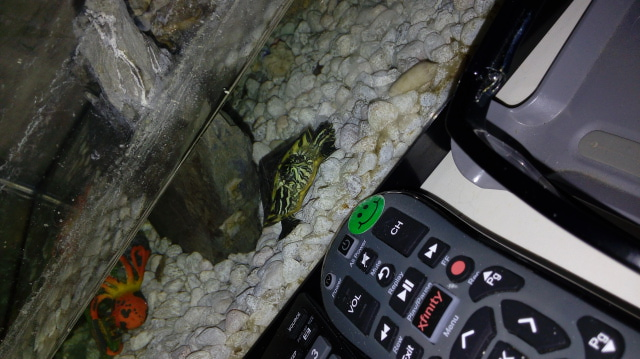 Yellow Bellied Slider Turtle
QuestionQUESTION: I got a baby Yellow Bellied slider tu
Yellow Bellied Slider Turtle
QuestionQUESTION: I got a baby Yellow Bellied slider tu
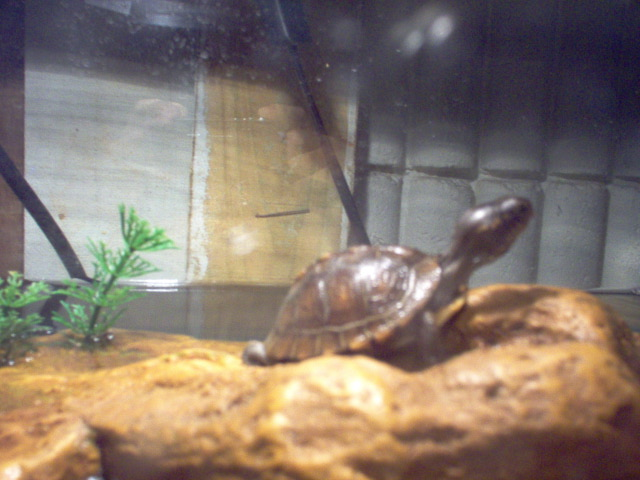 What kind of turtle is this???
QuestionMy turtle
2nd pic
QUESTION: My hu
What kind of turtle is this???
QuestionMy turtle
2nd pic
QUESTION: My hu
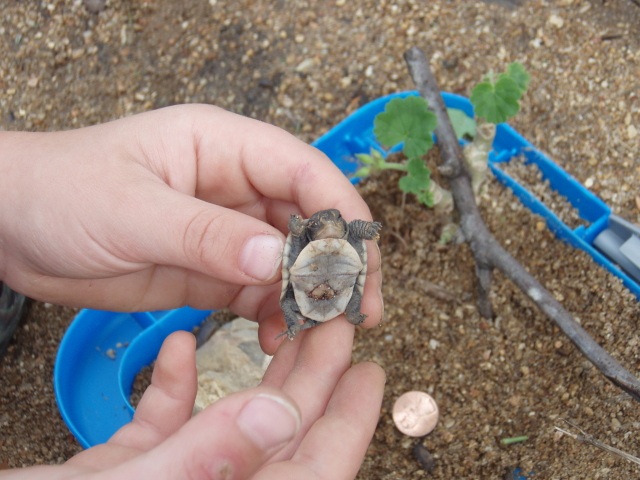 we found a newlly hatched turtle
QuestionTurtle Belly
QUESTION: My son Ben found
we found a newlly hatched turtle
QuestionTurtle Belly
QUESTION: My son Ben found